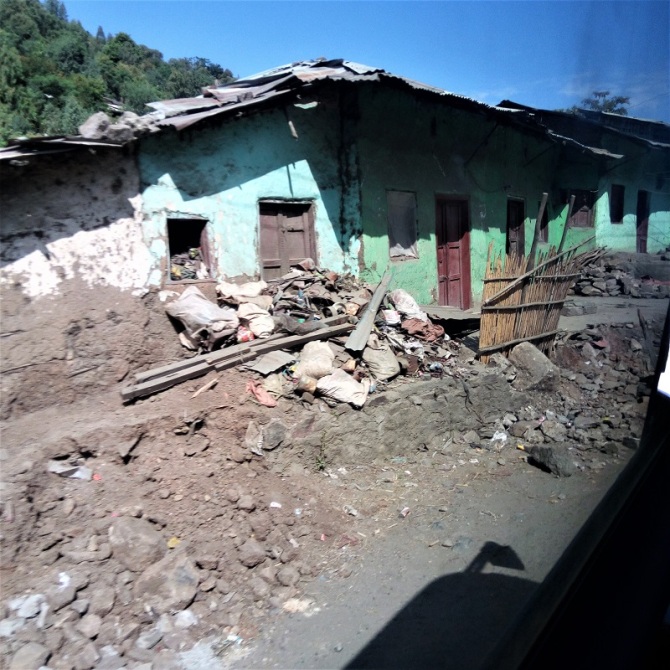

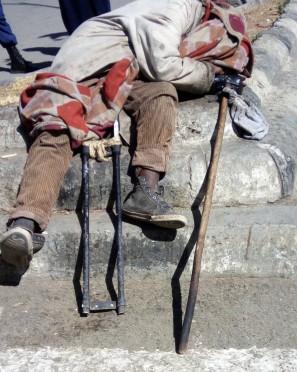 Photographs on this page were taken by the author in 2016 and 2017.
Photographs on this page were taken by the author in 2016 and 2017.
As I write this post, eight million and more Ethiopians are experiencing a drought and famine requiring emergency food aid, and it’s getting worse. Last year, at the height of the problems, over 15 million unfortunate Ethiopians were at risk for famine.
Watch this BBC video:
This post is about poverty and government oppression in Ethiopia and is from the perspective of my experience as a professor for four years in Ethiopia.
Don’t get me wrong, though. Ethiopia is a beautiful country, with amazing natural beauty and historical and archeological sites, astonishingly beautiful and rich cultural diversity, and so many wonderful people.
And there’s a handful of very nice areas in some of the big cities. I will share my photos of some of these on a happier post.
But wherever people live, extensive areas of poverty are evident, especially in rural areas, where over 80% of Ethiopians live. Even in its capital city, Addis Ababa, poverty abounds, but much of it is hidden from sight by tall trees, and fancy hotels and malls, close to where the poor and homeless beg on the streets, hoping for donations from the few who can afford to frequent those hotels and malls.
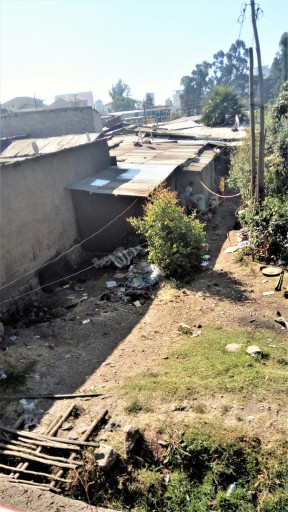
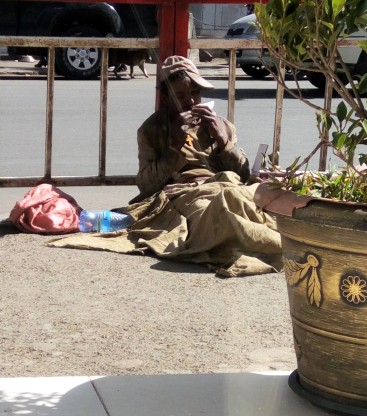
The above photos were taken by the author in Addis Ababa, January, 2017. Left- a poor housing district, similar to many in Ethiopia’s capital. Right: a poor beggar in the Piazza area of Addis, who told me he had come from another town hoping to find work, but ended up homeless, jobless and stranded.
You will see in the news, and officials of the oppressive Ethiopian government will smile persuasively, but deceptively, when they tell you that Ethiopia is thriving with a “double-digit” economic growth.
Yet many experts and scholars- and indeed most poor and oppressed citizens there- will explain to you why this claim to double-digit growth is really triple-digit nonsense and quadruple-digit propaganda.
Below are some articles worth reading. The third one is written by Professor Alemayehu Mariam, a human rights lawyer and professor at the University of California at San Bernadino, whose knowledge, scholarly and to-the-point opinions and analyses can be relied upon.
Ethiopia’s economic growth borrows from Enron’s accounting
Ethiopia’s double digit economic growth- reality check/
Is Ethiopia moving from a double-digit growth narrative to a collapsing economy?

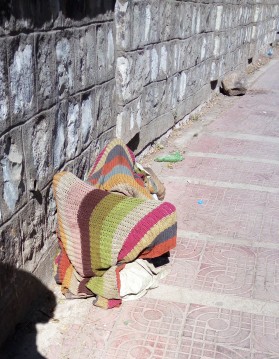
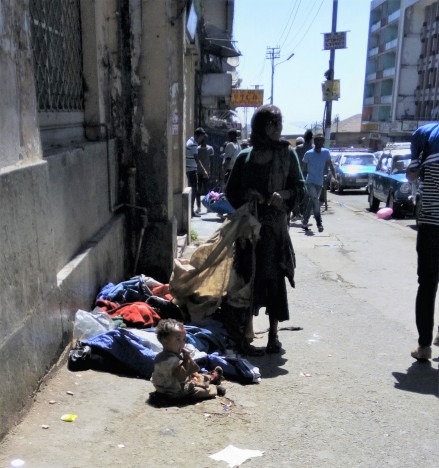
Photos taken by the author, of many photos taken between 2013 and 2017. Top, left: there are four mud-based homes in this photo, from Oromia, each one a single room perhaps 3 metres X 3 metres. One of the author’s many poor friends, a 32-year-old woman, lived with her brother in one of these homes. The other two photos show common street scenes in the capital, Addis.
Fact, fiction, and propaganda
“The poorest regions are in Chad, Burkino Faso, Niger, Ethiopia, South Sudan, Nigeria, Uganda and Afghanistan.”
The above quote is taken from Global Multidimensional Poverty Index 2017, a report of the Oxford Poverty and Human Development Initiative (OPHI). You can download a summary of this report here:
Global Multidimensional Index 2017
In fact, of 103 developing countries studied, Ethiopia ranks 101 out of 103 countries. It is the third poorest nation on Earth. Only two countries are poorer, by MPI score, than Ethiopia.
The global MPI is an index based on three “dimensions” of poverty: health, education and living standards, and on ten indications within these, including child mortality, access to nutrition, sanitation, quality drinking water, electricity, and more.
You see, poverty isn’t simply about money. It never was and never will be. It’s not simply about health either: You can vaccinate every Ethiopian against every vaccinatable disease, and you will barely influence their poverty. You can reduce child mortality with some measures, but if you still target those children because of their ethnicity, and let them grow up with poverty and oppression, what impact have you made on their lives?
Some governments- including the Ethiopian government- will use indicators such as GDP per capita as an indicator of progress, but GDP per capita is really a very poor indicator of human health and well being. Poverty is much, much more complex than that.
Poverty is about the quality of people’s lives, their access to education, their health, their access to quality food, and more- it’s about how they struggle to survive on a daily basis. It’s even- in my opinion- about how much freedom they have.
The Global MPI score is a scholarly index that takes some of these factors into account, and doesn’t just use GDP-based criteria as the main indicator.
And Ethiopia is doing very poorly. The MPI data for Ethiopia (http://www.dataforall.org/dashboard/ophi/index.php) indicate that:
- 87 % of Ethiopians are MPI-poor
- 71 % of Ethiopians live in severe poverty
- 58 % of Ethiopians are destitute
Even if you look at other methods of assessment of poverty, Ethiopia ranks as one of the poorest countries on the planet, despite what the regime wants you to think. The 2016 Human Development Report of the UNDP (United Nations Development Programme), for example, ranks Ethiopia 174 out of 188 countries, using Human Development Index scores:
After 26 years of appallingly oppressive rule by the current regime, Ethiopia remains one of the poorest nations on the face of the Earth. The government of Ethiopia, by the way, is dominated by members the Tigray People’s Liberation Front (TPLF), a group that was once classified as a terrorist organization and can be found in the Global Terrorism Database:
Having lived in Ethiopia for four years, I can, as an eye witness, vouch for the control, fear and intimidation that the regime brings to its citizens, and for the atrocities it continues to inflict upon its own people.
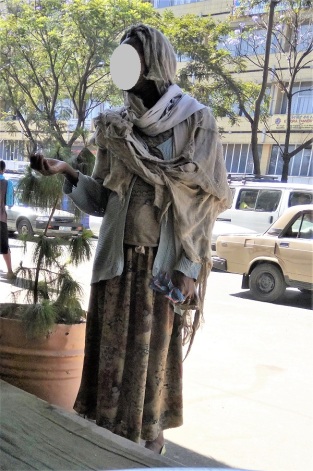
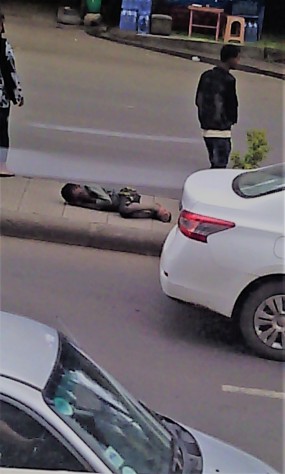
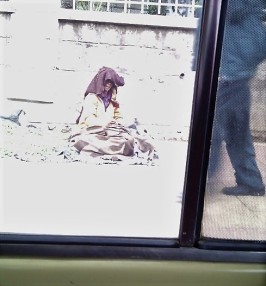
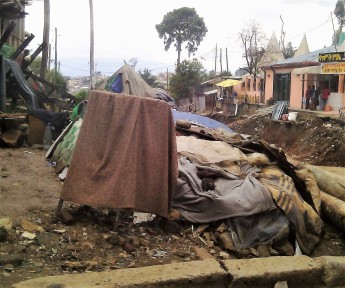
Photos (2016, 2017) taken by the author, in Addis Ababa. Top right: a young street boy lies helplessly by the roadside, ignored by passing cars and pedestrians. Street children are simply a “part of the furniture” in the capital and elsewhere. Bottom right: this pile of blankets, sticks and stones is a makeshift “home,” on the streetside, of a gentle, softly spoken woman in her 60s, who has lived here for several years- she came from the countryside to Addis after her husband died and ended up penniless and homeless. Weeks after this photo was taken, her “home” was dismantled by authorities and she moved to another area of the city.
I lived and worked as a professor for four years in Ethiopia and the poverty made me weep with sadness on almost a daily basis. I decided to make friends with scores of homeless and poor people, so I could learn about their tragic and so-sad stories. There was no shortage of these neglected, but amazing people.
The government presents a rosy image of an “Ethiopian Renaissance,” supporting it with its falsified “double-digit growth” statistics, but it is largely propaganda, and few people can speak out there because they are silenced by fear, oppression and proclamations that stifle free speech and human rights.
In Addis Ababa alone, estimates are that as many as 100,000 children, possibly even more, live on the streets. Add to that the homeless adults and families in Addis and elsewhere, and the number is not known, but it is staggering!
And we haven’t added yet the huge number of people who live on the edge, at risk of losing their basic security at a moment’s notice. When I lived in Ethiopia, I met many people who earned barely enough money to pay their rent and buy basic food, and I saw how precarious their lives were. Loss of a job, a serious illness or accident, loss of a working spouse, for example, can put someone on the streets at a moment’s notice.
In the countryside, as we speak, severe drought has put millions of poor Ethiopians at risk for famine. As of May, 2017, eight million Ethiopians (and rising) are in need of emergency food aid.
The Ethiopian government, over the past year, has begged for, and received, foreign aid to help its millions at risk for famine. Meanwhile, during last year’s drought, when over 15 million Ethiopians were at risk for famine, the Ethiopian government made a $510 million dollar deal with Japan Tobacco International that will expand tobacco farms, increase cigarette production, and increase smoking rates among its citizens:
Ethiopian government’s dirty tobacco deals
And what is happening to the other billions of dollars that the government should have available to help its poor and hungry? As a professor in a university in Ethiopia for four years, I was shocked at the degree of control of the university by government party-loyalists and the mismanagement, incompetence and corruption that I witnessed. You can read about this in the link below:
A 2017 report of an audit of state universities by the Ethiopian government itself found that, during the previous year, “illegitimate transactions” worth 20 billion birr (US$ 1,000,000,000) were made:
Ethiopia: audit gaps surge, Parliament condemns itself
To quote the above report:
“The Auditor General, in its latest report, revealed illegitimate transactions close to 20 billion Br in 158 federal institutions during the past fiscal year – over twice that of the gap seen in 2014/15. This was announced when the Auditor General presented its report of government institutions to the Parliament on May 30, 2017.
In Addis Ababa University alone, $200,000 EVERY DAY is lost in “illegitimate transactions.” And when you look at 158 academic institutions, mainly universities, in Ethiopia, over $2.5 million dollars DAILY ($1 billion yearly) goes missing from “illegitimate transactions!
That “stolen” $1,000,000,000 could do so many, many wonderful things for the poor Ethiopians who really need and deserve it!
The extent of the corruption and mismanagement is surely enough to make any good person weep uncontrollably!
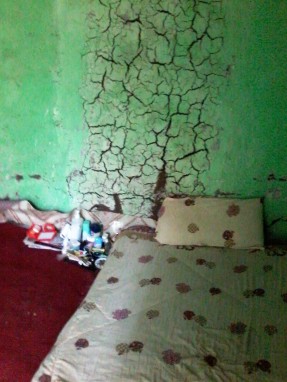
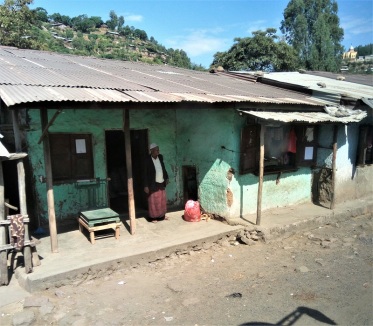
Photos taken by the author in 2016. Left, a single-room home, mud-based, with no running water, in the capital city, Addis Ababa, belonging to one of the author’s friends, a young lady who worked as a store assistant 50 hours weekly, and was paid 1500 birr ($75) monthly. The rent cost 700 birr ($35) monthly, leaving her with $35 a month for food and living costs. Many people even with basic jobs are living on the edge, between homelessness and basic living standards.
Freedom House Ranking
I would argue that we should add indices of freedom to the definition of poverty. After all, deprivation of a person’s rights to freedom of speech and expression is surely a type of psychosocial poverty? If that were the case, Ethiopia might well fall to the very bottom of the list.
Freedom House lists Ethiopia as “NOT FREE,” and even trending down in 2017:
If people have no freedom to speak out against poverty and its causes, to campaign for a better deal for the poor- if they have no voice because their mouths are glued shut by state oppression- then they will be confined helplessly and hopelessly by the chains and shackles of poverty.
Peace Index and Fragile State Index Rankings
But we’re not finished yet with statistics that forewarn us of impending calamity for the oppressed people of Ethiopia. The Global Peace Index 2017 listed Ethiopia as the country with the greatest decline in peace worldwide, out of 163 countries studied.
Global Peace Index 2017: Ethiopia suffered the biggest decline of all countries
In the 2017 Fragile States Index, Ethiopia ranked the 15th most “fragile” country, out of 178, based on 12 indicators of social, political and economic criteria that contribute to a nation’s risk of instability, out of 178 countries.
Ethiopia was the country with the worst decline in Fragility Index in the past year:
After 26 years of ethnic targeting, ethic favouritism, genocide and state oppression by their government, largely ignored by the outside world, too many Ethiopians are sick and tired of a deceitful regime that utterly controls them and keeps them gagged, poor and helpless.
In the past year, things have come to a head. In October, 2016, the government declared a state-of-emergency, extended the state-of-emergency in March 2017, and uses that state-of emergency to control and silence its people even more. All hell then broke loose in September, 2017, when apparent ethnic conflict broke out between the Oromo and Somali people in Ethiopia, leading to hundreds of deaths and injuries, and displacement of thousands of Oromos from their homes. There is every reason to believe, from reports, that this conflct was deliberately planned and instigated by the central Ethiopian government itself, for complex reasons that are beyond the scope of this article, but not the least because the government has destructively targeted Oromos ethnically for decades.
The wealthiest people in Ethiopia
There are wealthy people in Ethiopia, but there are many, many, many, many more poor people there.
The richest person there is said to be businessman, Sheikh Mohammed Al Amoudi; he is worth about $11 billion.
The Tigray People’s Liberation Front (TPLF), which controls everything in Ethiopia, also controls all big business and wealth, and uses much of this cash to fill the pockets of corrupt government officials and party-loyalists, and to control its citizens, through, for example, military oppression and state surveillance and censorship.
While the government receives billions of dollars in foreign aid that helps corrupt politicians and government officials amass their wealth, millions of precious citizens live in poverty or on the fence between poverty and very minimal security.
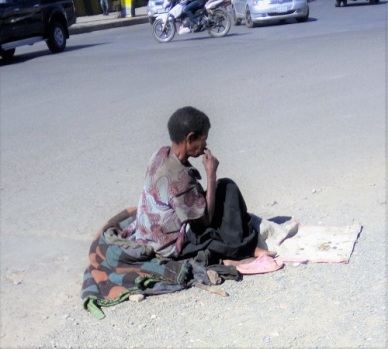
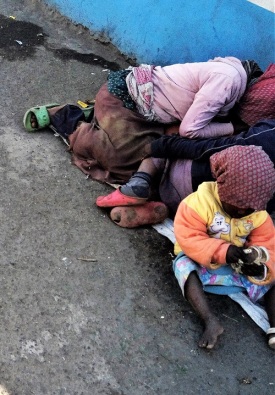
Common scenes on the streets of Addis. Photos taken in 2017 by the author. Left, an elderly woman. Right: A family from out of Addis who came to the capital because of poverty and drought in their home in the countryside.
If you ask me, though, who are really the wealthiest people in Ethiopia, I will tell you beyond doubt who they are, because when I lived there I made a point of getting to know some of them, and I listened to their tragic stories. They are the homeless, and the poor who live on the borderline, many of them rich in humility, spirit and gentleness, who somehow manage to produce the best smiles you ever saw in your life. But behind those priceless smiles, there are stories of horrific tragedy and oppression.
And the poorest? The oppressive leaders, shamefully poor in humanity, who silence those who want to speak out for the rights of people, through intimidation and unethical proclamations that make a mockery of the Ethiopian Constitution and stifle human rights.

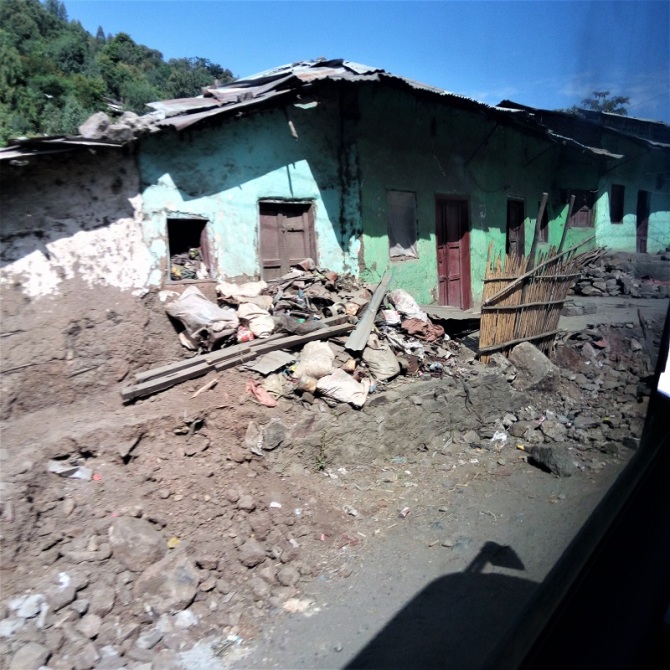
I am million % agreed with the writer because I too spend one year in Ethiopia while working in Addis Pharmaceutical Factory as Sales and Marketing Manager. Worthless article for Ethiopian officials to implement for the poor nation. Regards
Muhammad Bilal Jadoon
Centre Manager
Comwave Institute of Science and IT Abbottabad
Pakistan
mbkjadoon@yahoo.com
LikeLiked by 1 person
WELL OBSERVED AND TOLD
LikeLiked by 1 person